| Topic: DRAGONS UNICORNS MERMAIDS PEGASUS OTHER MYTHIC ANIMALS | |
|---|---|
|
I think there cool, I never had that much of a chance to take care of one, I heard they were high maintanence to take care of, and I always had cats gerbils fish dogs, animals like that.
|
|
|
|
|
|
They are allot to take care of.
|
|
|
|
|
|
Oh and two tarantula spiders
 
|
|
|
|
|
|
Edited by
tazzops
on
Sun 07/17/11 05:47 PM
|
|
|
The only other animals I had were just dogs and cats, and a crazy ferret. And birds and farm animals.
|
|
|
|
|
|
And two pygmy goats, and rabbits, my Grandma had three ferrets, ferrets are crazy, she had a hard time taking care of them so she had to give them away.
|
|
|
|
|
|
Ferrets are indeed crazy.
|
|
|
|
|

|
|
|
|
|
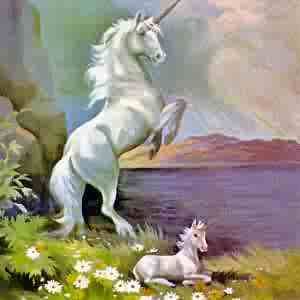
|
|
|
|
|

|
|
|
|
|

|
|
|
|
|
 It would be grand to see this. |
|
|
|
|
 Too Bad they missed the Ark. |
|
|
|
|
|
Edited by
tazzops
on
Mon 07/18/11 08:14 AM
|
|
 Medusa (Greek: Μέδουσα, Médousa, "guardian, protectress") and some times known as the Gorgon, was a monstrous chthonic female character essentially an extension of an apotropaic mask whose gaze could turn on-lookers to stone. She was born of Phorcys and Ceto or in some cases, Typhon and Echidna (Pre-Titan gods). She had two sisters, Stheno and Euryale both of whom were immortal. Medusa on the other hand was not. They lived on an island at the end of the world. In other versions she was a human with blonde hair and she had no sisters. She slept with Poseidon in Athena's temple, so Athena punished Medusa by turning her into a monster with hair made of snakes and is sometimes described to be half snake herself! Perseus was instructed by his soon to be father to get the Gorgon's head. He used Hades's clap of invisibility, winged sandals from Hermes, a sword and a mirrored shield. After slicing her head off in her sleep, Pegasus and the giant Chrysaor sprouted. Perseus then flew off the island on Pegasus to escape her sisters who had woken up! He later returned to his soon to be father and turned him to stone with the gorgon's head.  |
|
|
|
|
|
Edited by
tazzops
on
Mon 07/18/11 08:19 AM
|
|
 In Greek mythology a cyclops (pronounced /ˈsaɪklɒps/), or kyklops (Greek Κύκλωψ), is a member of a primordial race of giants, each with a single eye in the middle of its forehead. The plural is cyclopes (pronounced IPA: /saɪˈkloʊpiːz/) or kyklopes (Greek Κύκλωπες). In English, the plural cyclopses is also used. The name is widely thought to mean "round-" or "wheel-eyed". Hesiod describes one group of cyclopes and Homer describes another. In Hesiod's Theogony, Zeus releases three Cyclopes, the sons of Uranus and Gaia, from the dark pit of Tartarus. They provide Zeus's thunderbolt, Hades' helmet of invisibility, and Poseidon's trident, and the gods use these weapons to defeat the Titans. In a famous episode of Homer's Odyssey, the hero Odysseus encounters the Cyclops Polyphemus, the son of Poseidon and a nereid (Thoosa), who lives with his fellow Cyclopes in a distant country. The connection between the two groups has been debated in antiquity and by modern scholars. Hesiod's Cyclops In the Theogony, the Cyclopes – Arges, Brontes, and Steropes – were the primordial sons of Uranus (Sky) and Gaia (Earth) and brothers of the Hecatonchires. They were giants with a single eye in the middle of their forehead and a foul disposition. According to Hesiod, they were strong, stubborn, and "abrupt of emotion". Collectively they eventually became synonyms for brute strength and power, and their name was invoked in connection with massive masonry. They were often pictured at their forge. Uranus, fearing their strength, locked them in Tartarus. Cronus, another son of Uranus and Gaia, later freed th e Cyclopes, along with the Hecatonchires, after he had overthrown Uranus. Cronus then placed them back in Tartarus, where they remained, guarded by the female dragon Campe, until freed by Zeus. They fashioned thunderbolts for Zeus to use as weapons, and helped him overthrow Cronus and the other Titans. The thunderbolts, which became Zeus' main weapons, were forged by all three Cyclopes, in that Arges added brightness, Brontes added thunder, and Steropes added lightning. These Cyclopes also created Poseidon's trident, Artemis' bow and arrows of moonlight, Apollo's bow and arrows of sun rays, and the helmet of darkness that Hades gave to Perseus on his quest to kill Medusa. According to a hymn of Callimachus, they were Hephaestus' helpers at the forge. The Cyclopes were said to have built the "cyclopean" fortifications at Tiryns and Mycenae in the Peloponnese. The noises proceeding from the heart of volcanoes were attributed to their operations. Apollo slew the Cyclopes in revenge when Zeus killed his son, Asclepius, with a Cyclopes-forged thunderbolt. Homer's Cyclopes The Cyclopes were huge one-eyed monsters that resided on an island with the same name. Commonly, the term "Cyclops" refers to a particular son of Poseidon and Thoosa named Polyphemus who was a Cyclops. Another member of this group of Cyclopes was Telemus, a seer. Polyphemus In Book 9 of Homer's Odyssey, a scouting party led by Odysseus lands on the Island of the Cyclopes and discovers a large cave. They enter into the cave and feast on food they find there. This cave is the home of Polyphemus, who soon returns. Odysseus and his crew attempt to befriend him in the cave; but he traps them instead. He proceeds to eat several crew members, whereupon Odysseus devises a cunning plan for escape. To make Polyphemus unwary, Odysseus gives him a skin of very strong, unwatered wine. When Polyphemus asks for Odysseus' name, he tells him that it is 'Outis', Greek for 'no man' or 'nobody'. Once the giant falls asleep as a result of being drunk, Odysseus and his men take the spit from the fire and drive it through Polyphemus' only eye. Polyphemus' cries of help are answered by the others of his race; however, they turn away from aiding him when they hear that "Nobody" is the cause of his woes. In the morning, Odysseus ties his men and himself to the undersides of Polyphemus' sheep. When the Cyclops lets the sheep out to graze, the men are carried out. Since Polyphemus has been blinded, he cannot see the men, but feels the backs of his sheep to make himself sure that the men are not riding them. As he sails away, Odysseus shouts "Cyclops, when your father asks who took your eye, tell him that it was Odysseus, Sacker of Cities, Destroyer of Troy, son of Laertes, and King of Ithaca", which proves to be a catastrophic example of hubris. Knowing his attacker's name, Polyphemus asks his father Poseidon to prevent Odysseus from returning home to Ithaca, or to at least deprive him of his ship and crew. This tale from the Odyssey is more humorously told in the only surviving satyr play, entitled Cyclops by Euripides. The Sicilian Greek poet Theocritus wrote two poems circa 275 BC concerning Polyphemus' desire for Galatea, a sea nymph. When Galatea instead married Acis, a Sicilian mortal, a jealous Polyphemus killed him with a boulder. Galatea turned Acis' blood into a river of the same name in Sicily. Origins Walter Burkert among others suggests that the archaic groups or societies of lesser gods mirror real cult associations: "it may be surmised that smith guilds lie behind Cabeiri, Idaian Dactyloi, Telchines, and Cyclopes." Given their penchant for blacksmithing, many scholars believe the legend of the Cyclopes' single eye arose from an actual practice of blacksmiths wearing an eyepatch over one eye to prevent flying sparks from blinding them in both eyes. The Cyclopes seen in Homer's Odyssey are of a different type from those in the Theogony; they were most likely much later additions to the pantheon and have no connection to blacksmithing. It is possible that legends associated with Polyphemus did not make him a Cyclops before Homer's Odyssey; Polyphemus may have been some sort of local daemon or monster originally. Another possible origin for the Cyclops legend, advanced by the paleontologist Othenio Abel in 1914, is the prehistoric dwarf elephant skulls – about twice the size of a human skull – that may have been found by the Greeks on Crete and Sicily. Abel suggested that the large, central nasal cavity (for the trunk) in the skull might have been interpreted as a large single eye-socket. Given the inexperience of the locals with living elephants, they were unlikely to recognize the skull for what it actually was. Veratrum album, or white hellebore, an herbal medicine described by Hippocrates before 400 BC, contains the alkaloids cyclopamine and jervine, which are teratogens capable of causing cyclopia (holoprosencephaly). Students of teratology have raised the possibility of a link between this developmental deformity and the myth sharing its name. 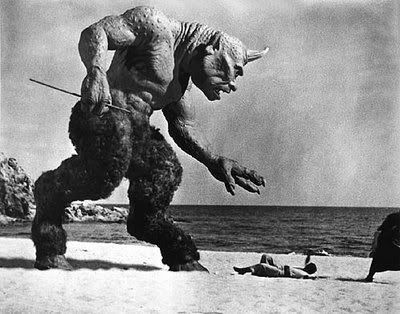 |
|
|
|
|
|
Edited by
tazzops
on
Mon 07/18/11 09:19 AM
|
|
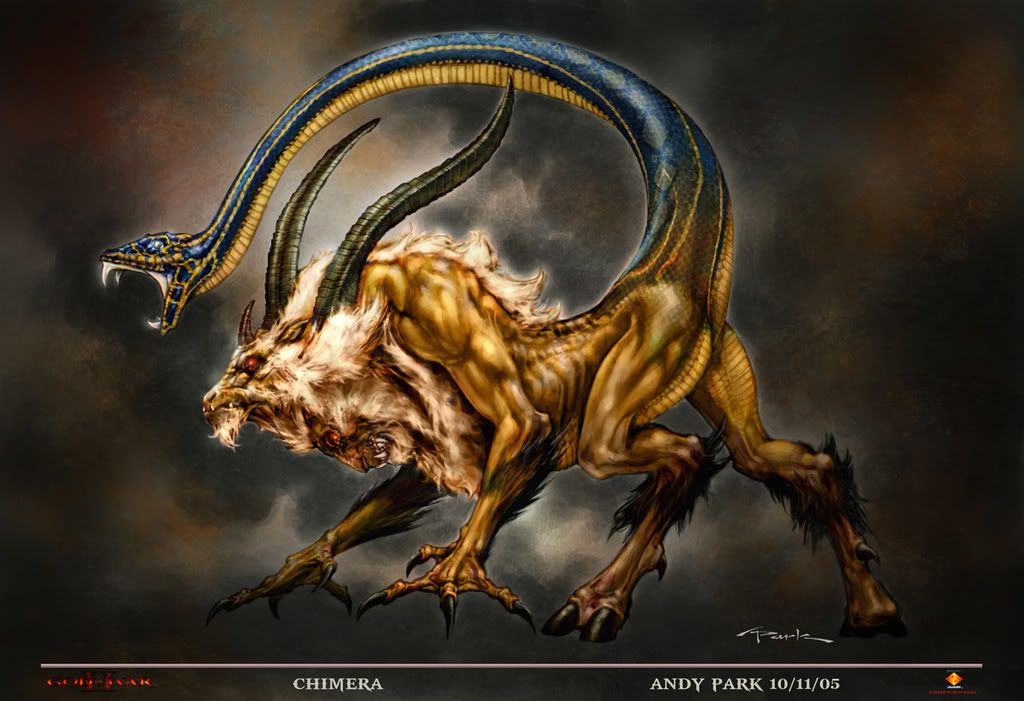 The Chimera was a monstrous beast which ravaged the countryside of Lycia in Anatolia that was to be able to breath fire. There have been many discriptions of how it looks but in all the descriptions it is part lion, goat and snake. The hero Bellerophon was commanded to slay it by King Lobates. He rode into battle against the beast on the back of the winged horse Pegasus and, driving a lead-tipped lance down the Chimeras flaming throat, suffocating her. The Chimera may have once been identified with the winter-rising Constellation Capricorn (the serpent-tailed goat). Next to the dragon, the chimera is the second most popular beast to guard portals. The chimera is also female and is the youngest daughter of Echidna and Typhon. She is also said to be the last child the two had together. The word chimera is also used in modern pop-culture within both the fantasy and science-fiction communities to refer to unnatural beings created from the combination of two or more animals by means other than breeding. 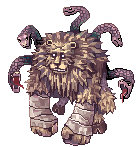  |
|
|
|
|
|
Edited by
tazzops
on
Mon 07/18/11 09:37 AM
|
|
 Hydra is an ancient Greek mythical beast that was mentioned in the tale of the twelve labours of Hercules (also called Heracles). The hydra has 9 heads, the number of head varies from different versions of the legend, however, more accounts agree on nine. It was said that the middle one was immortal and it has very poisonous venom and breath. If the heads are cut off, the heads would grow back. One head cut-off would result to two heads growing back in its place. The Hydra was believed to have lived in the Lernean marsh which is located near Argolis, the region around Argos, Greece. The serpent-woman Echinda and the hundred headed Typhon are Hydra’s parents. His siblings include the Nemean lion, Cerberus, Chimer and Ladon. The Hydra guards the entrance to the Underworld and from the murky swamps of the Lake of Lerna the monstrous serpent would rise and terrorize the city. The Hydra was finally killed by Hercules during his second labor. Killing the Hydra: The Second Labor of Hercules Accompanied with his trusty nephew, Iolaus, Hercules set off to hunt the nine-headed monster. They went to the springs of Amymone and discovered the lair of the menacing beast. Hercules lured the creature out of its den by shooting it with flaming arrows. When the beastly creature emerged, the Greek mythical hero seized it but the monster wound one of its coils to Hercules’ foot. With one of his foot stuck, Hercules tried to break free by smashing the monster’s head, but as soon as he cut one, two more heads would appear on its place. And a huge crab began biting Hercules’ trapped foot to add nuisance. After smashing the crab with his club, Hercules called on to his nephew, Iolaus to help him out in fighting the looming monster. Hercules persisted on slashing the monster’s head while Iolaus scorched each headless neck with a torch to prevent heads from growing back. Finally, with the two fighting the monstrous beast together, they were able to kill the eight mortal heads. Hercules finished the monster off by chopping the ninth head, which is the immortal head and buried it by the side of the road near Lerna and Elaeus. He buried the head and proceeded to cover it with a huge rock. As for the rest of the beasts body, he rip the dead body open and soaked the tip of his arrows to its venomous blood. Other versions: Some accounts say that Hydra’s legend came about from exaggerated stories about a huge squid or an octopus. While Hydra has the ability to grow back its cut off heads, the octopus also has the ability to grow back its arms when cut off, thus the similarity.  |
|
|
|
|
 Medusa (Greek: Μέδουσα, Médousa, "guardian, protectress") and some times known as the Gorgon, was a monstrous chthonic female character essentially an extension of an apotropaic mask whose gaze could turn on-lookers to stone. She was born of Phorcys and Ceto or in some cases, Typhon and Echidna (Pre-Titan gods). She had two sisters, Stheno and Euryale both of whom were immortal. Medusa on the other hand was not. They lived on an island at the end of the world. In other versions she was a human with blonde hair and she had no sisters. She slept with Poseidon in Athena's temple, so Athena punished Medusa by turning her into a monster with hair made of snakes and is sometimes described to be half snake herself! Perseus was instructed by his soon to be father to get the Gorgon's head. He used Hades's clap of invisibility, winged sandals from Hermes, a sword and a mirrored shield. After slicing her head off in her sleep, Pegasus and the giant Chrysaor sprouted. Perseus then flew off the island on Pegasus to escape her sisters who had woken up! He later returned to his soon to be father and turned him to stone with the gorgon's head.  |
|
|
|
|
|
Edited by
tazzops
on
Mon 07/18/11 10:06 AM
|
|
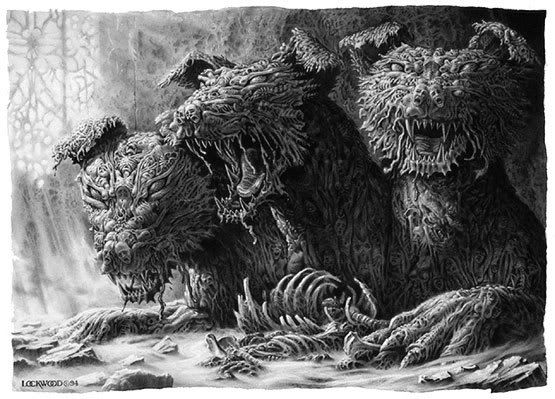 Here kitty kitty.  Cerberus There is only one Cerberus know to exist in classic mythology. In Greek and Roman mythology, Cerberus (derived from Greek "kerberos") is the guardian of the gates of the Underworld, Hades. Its sole purpose is to prevent doomed souls from escaping. Cerberus; like his brother, Orthrus, and many other monsters of Greek mythology was spawned from Echidna, also known as the mother of all monsters. It is most commonly depicted as a giant dog with three heads, and sometimes a mane composed of snakes, much like the hair of the gorgon, Medusa. Some renderings portray the beast with one single tail; others two, sometimes three. The tail(s) is/are that of a serpent. The Cerberus is regarded as a great and fearsome creature and is the original and is also considered a neutral creature because he takes doomed souls to the underworld where they belong. Some think that the Hell Hound is a distant cousin of the Cerberus. |
|
|
|
|
|
Edited by
tazzops
on
Mon 07/18/11 10:52 AM
|
|
  Kitsune are from Japanese folklore and are Japanese foxes. A kitsune can have up to nine tails, depending on its age, wisdom and power. The only way to kill a kitsune is to cut off all of its tails, as it is said that one of the tails is its main tail and the source of all its power. Not knowing which tail is the main one, one would have to cut off all its tails to kill it.One, five, seven, and nine tails are the most common numbers in folk stories. When a kitsune gains its ninth tail, its fur becomes white or gold. A kitsune is a shapeshifter, and usually when it reaches the age of 100 years, it learn the ability to take on a human form. Thus, they have to be a fox for a hundred years before it can shapeshift from a fox to a human and back again. It is also said that a kitsune can duplicate other human beings, in other words shapeshift into the look-a-likes of different people. Kitsune can be either male or female, and usually take the form of young Japanese girls, beautiful women and older men. Kitsune are believed to possess superior intelligence, long life, and magical powers. They are a type of spiritual entity, and the word kitsune is often translated as fox spirit. However, this does not mean that kitsune are ghosts, nor that they are fundamentally different from regular foxes. Because the word spirit is used to reflect a state of knowledge or enlightenment, all long-lived foxes gain supernatural abilities. There are two common classifications of kitsune. The zenko (善狐, literally good foxes) are benevolent, celestial foxes associated with the god Inari; they are sometimes simply called Inari foxes. On the other hand, the yako (野狐, literally field foxes, also called nogitsune) tend to be mischievous or even malicious. Local traditions add further types. For example, a ninko is an invisible fox spirit that human beings can only perceive when it posseses them. Another tradition classifies kitsune into one of thirteen types defined by which supernatural abilities the kitsune possesses. Physically, kitsune are noted for having as many as nine tails. These kyūbi no kitsune (九尾の狐, nine-tailed foxes) gain the abilities to see and hear anything happening anywhere in the world. Other tales attribute them infinite wisdom (Omniscence). There are thirteen different kinds of Kitsune, each with a corresponding element, listed as follows: Heaven (or Celestial or Prime), Void (or Dark), Wind, Spirit, Fire, Earth, River, Ocean, Mountain, Forest, Thunder, Time and Sound. One of the most important things to a Kitsune is freedom. They do not fare well to being locked away, and do not like to be forced to do something they don't want to. Doing something like that would be likely to get you killed if they are freed. Kitsune love playing tricks. They like to take things and hide them from people, or do just about anything else to piss someone off. Kitsunes' have things called Kitsune balls, or star balls, which is a small white-gold ball that is a Kitsune's most prized possession, since it is almost like their life force in a ball. If you get your hands on a Kitsune's star ball, you would have the ability to control the Kitsune, and make it do your bidding. However, Kitsune hate being stripped of their freedom, and when the Kitsune gets its star ball back, there will be serious repercussions for you to deal with. In some stories, kitsune have difficulty hiding their tails when they take human form; looking for the tail, perhaps when the fox gets drunk or careless, is a common method of discerning the creature's true nature. Variants on the theme have the kitsune retain other foxlike traits, such as a coating of fine hair, a fox-shaped shadow, or a reflection that shows its true form. Kitsune-gao or fox-faced refers to human females who have a narrow face with close-set eyes, thin eyebrows, and high cheekbones. Traditionally, this facial structure is considered attractive, and some tales ascribe it to foxes in human form. Kitsune have a fear and hatred of dogs even while in human form, and some become so rattled by the presence of dogs that they revert to the shape of a fox and flee. A particularly devout individual may be able to see through a fox's disguise automatically. One folk story illustrating these imperfections in the kitsune's human shape concerns Koan, a historical person credited with wisdom and magical powers of divination. According to the story, he was staying at the home of one of his devotees when he scalded his foot entering a bath because the water had been drawn too hot. Then, "in his pain, he ran out of the bathroom naked. When the people of the household saw him, they were astonished to see that Koan had fur covering much of his body, along with a fox's tail. Then Koan transformed in front of them, becoming an elderly fox and running away." Other supernatural abilities commonly attributed to the kitsune include possession, mouths or tails that generate fire or lightning (known as kitsune-bi; literally, fox-fire), willful manifestation in the dreams of others, flight, invisibility, and the creation of illusions so elaborate as to be almost indistinguishable from reality. Some tales speak of kitsune with even greater powers, able to bend time and space, drive people mad, or take fantastic shapes such as a tree of incredible height or a second moon in the sky. Other kitsune have characteristics reminiscent of vampires or succubi and feed on the life or spirit of human beings, generally through sexual contact. Kitsunetsuki Kitsunetsuki (狐憑き or 狐付き; also written kitsune-tsuki) literally means the state of being possessed by a fox. The victim is always a young woman, whom the fox enters beneath her fingernails or through her breasts. In some cases, the victims' facial expressions are said to change in such a way that they resemble those of a fox. Japanese tradition holds that fox possession can cause illiterate victims to temporarily gain the ability to read. Though foxes in folklore can possess a person of their own will, Kitsunetsuki is often attributed to the malign intents of hereditary fox employers, or tsukimono-suji. Exorcism, often performed at an Inari shrine, may induce a fox to leave its host if it is possessing someone. In the past, when such gentle measures failed or a priest was not available, victims of kitsunetsuki were beaten or badly burned in hopes of forcing the fox to leave. Entire families were ostracized by their communities after a member of the family was thought to be possessed. In Japan, kitsunetsuki was noted as a disease as early as the Heian period and remained a common diagnosis for mental illness until the early 20th century. Possession was the explanation for the abnormal behavior displayed by the afflicted individuals. In the late 19th century, Dr. Shunichi Shimamura noted that physical diseases that caused fever were often considered kitsunetsuki. The belief has lost favor, but stories of fox possession still appear in the tabloid press and popular media. One notable occasion involved allegations that members of the Aum Shinrikyo cult had been possessed. In medicine, kitsunetsuki is an ethnic psychosis unique to Japanese culture. Those who suffer from the condition believe they are possessed by a fox. Symptoms include cravings for rice or sweet red beans, listlessness, restlessness, and aversion to eye contact. Kitsunetsuki is similar to but distinct from clinical lycanthropy. Tricksters Kitsune are often presented as tricksters, with motives that vary from mischief to malevolence. Stories tell of kitsune playing tricks on overly proud samurai, greedy merchants, and boastful commoners, while the crueler ones abuse poor tradesmen and farmers or devout Buddhist monks. Their victims are usually men; women are possessed instead. For example, kitsune are thought to employ their kitsune-bi or fox-fire to lead travelers astray in the manner of a will o' the wisp. Another tactic is for the kitsune to confuse its target with illusions or visions. Other common goals of trickster kitsune include seduction, theft of food, humiliation of the prideful, or vengeance for a perceived slight. Kitsune keep their promises and strive to repay any favor. Occasionally a kitsune attaches itself to a person or household, where they can cause all sorts of mischief. Other kitsune use their magic for the benefit of their companion or hosts as long as the human beings treat them with respect. As yōkai, however, kitsune do not share human morality, and a kitsune who has adopted a house in this manner may, for example, bring its host money or items that it has stolen from the neighbors. Accordingly, common households thought to harbor kitsune are treated with suspicion. Oddly, samurai families were often reputed to share similar arrangements with kitsune, but these foxes were considered zenko and the use of their magic a sign of prestige. Abandoned homes were common haunts for kitsune. One 12th-century story tells of a minister moving into an old mansion only to discover a family of foxes living there. They first try to scare him away, then claim that the house "has been ours for many years, and . . . we wish to register a vigorous protest." The man refuses, and the foxes resign themselves to moving to an abandoned lot nearby. Tales distinguish kitsune gifts from kitsune payments. If a kitsune offers a payment or reward that includes money or material wealth, part or all of the sum will consist of old paper, leaves, twigs, stones, or similar valueless items under a magical illusion. True kitsune gifts are usually intangibles, such as protection, knowledge, or long life. Wives and lovers Kitsune are commonly portrayed as lovers, usually in stories involving a young human male and a kitsune who takes the form of a human woman. The kitsune may be a seductress, but these stories are more often romantic in nature. Typically, the young man unknowingly marries the fox, who proves a devoted wife. The man eventually discovers the fox's true nature, and the fox-wife is forced to leave him. In some cases, the husband wakes as if from a dream, filthy, disoriented, and far from home. He must then return to confront his abandoned family in shame. Many stories tell of fox-wives bearing children. When such progeny are human, they possess special physical or supernatural qualities that often pass to their own children. The astrologer-magician Abe no Seimei was reputed to have inherited such extraordinary powers. Other stories tell of kitsune marrying one another. Rain falling from a clear sky — a sunshower — is called kitsune no yomeiri or the kitsune's wedding, in reference to a folktale describing a wedding ceremony between the creatures being held during such conditions.The event is considered a good omen, but the kitsune will seek revenge on any uninvited guests. 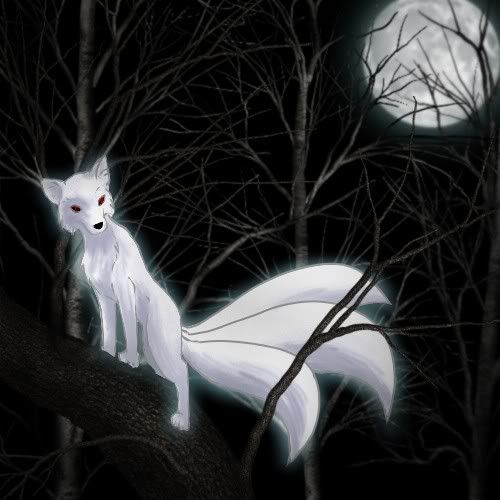   |
|
|
|
|
|
Edited by
tazzops
on
Mon 07/18/11 11:01 AM
|
|
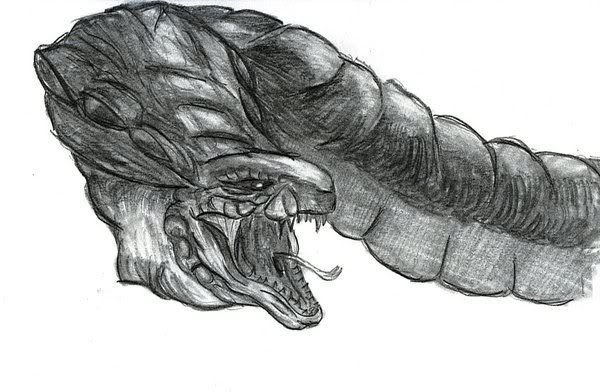 Imoogi A close relative to the dragon, there is a native Korean mythological creature known as an Imugi. By one account, they are hornless creatures resembling dragons who have been cursed and thus were unable to become dragons. By other accounts, an Imugi is a proto-dragon which must survive one thousand years in order to become a fully fledged dragon. In either case they are said to be large, benevolent, python-like creatures that live in water or caves. Their sighting is associated with good luck. In the 21st-century Korean film titled D-War, two Imoogi, of which one was benevolent and the other evil, were seen competing for possession of a source of power by which one of them could become a dragon. Ultimately, the evil Imoogi is destroyed by his rival moments after the latter had captured the source. Here, the two are shown to be physically different, in that the evil Imoogi is darker-colored, more slender, and distinguished by an inflexible hood similar to that of a cobra, whereas the good Imoogi is paler, stockier, and hoodless. Narration in the film implies that many Imoogi exist at a time, whereof one is designated to become a dragon. The Alosha series by Christopher Pike features a variation of the Imoogi called a "koul". A koul is a snakelike, gigantic proto-dragon that must pass three tests of courage — the coming to aid of others, the act of swimming, and a literal 'leap' of faith — in order to become a dragon. Upon coming to the aid of others, the koul grows legs; after having swum in water, the koul is able to breathe fire; upon making the leap, the koul immediately sprouts wings. A successful koul resembles a European dragon, whereas a koul who has completed only one or two of its tests resembles a Chinese dragon or Korean dragon of the type described above. 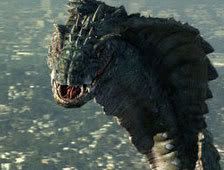 |
|
|
|
|








